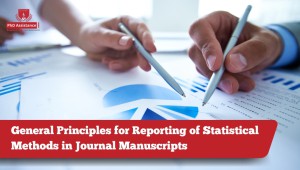Principles for reporting statistical methods
General Principles for Reporting of Statistical Methods in Journal Manuscripts
Principles for Reporting of Statistical Methods

Recent Post
Introduction
The importance of clear and accurate reporting of statistical methods is vital for the integrity, credibility, and reproducibility of scientific research (American Statistical Association [ASA], 2022; EQUATOR Network, 2024). Reporting on statistical analysis is much more than an ethical/technical requirement; it is an integral part of trustworthiness and interpretability of findings from research. Empirical assessments provide clear and actionable evidence of disparities in the way statistical analyses are documented, thus contributing to a larger reproducibility crisis related to science (Gosselin, 2021; Xiong & Cribben, 2022).
This manuscript will offer best practices for reporting the statistical procedures conducted in journal manuscripts and will incorporate what we see as current scholarly guidance to promote transparency of the study methods and integrity of science.
Preliminary Analyses
2. Deriving Variables
3. Categorisation
4. Merging Categories
5. Outlier Identification
Classifying outliers, including any z-score and/or other methodologies (for instance, Mahala Nobis distance, Cook’s distance) and sensitivity analysis, if any, that assesses the impact on results should be explicitly stated.
Where feasible, the above practices facilitate reproducibility since they lead the reader to acknowledge and repeat the original manipulation of the dataset (ASA, 2022; Keppler et al., 2022).
1. Analytical Objectives
All analyses should correspond to a specified research hypothesis; therefore, it is written, “A t-test (parametric statistical analysis) was used to determine if intervention A significantly reduced systolic blood pressure above and beyond what was accounted for in the control.” This provides context (Giofrè et al., 2022).
2. Variable Definitions and Descriptive Statistics
3.Clinically Meaningful Thresholds
4. Assumption Testing
5. Adjustment for Multiple Comparisons
6. Directionality and Significance Levels
7. Statistical Software and Packages
1. Sensitivity analysis
2. Missing Data Handling
3. Validation of Assumptions
4. Post Hoc or Exploratory Analyses
Independent researchers can reproduce results through reproducibility, utilising the same dataset and code (Xiong & Cribben, 2022). Best practices, including open science practices such as sharing the code via GitHub or providing statistical notebooks (e.g., R Markdown, Jupyter), are increasingly adopted (ASA, 2022).
In welcome showing what journals prescriptively demanded of authors to report confidence intervals and open data, they did significantly improve the quality of statistical reports. Similarly, the findings enabled correcting discrepancies between the assessed and reported p-values to assist reviewers and readers in checking analytical accuracy (Heston, 2023).
Further pre-registration and publication of analysis plans help enhance reproducibility by limiting exploratory data analysis and optionality within a data analysis (Pownall et al., 2023).
Discussion and Implications
A standardised reporting of statistical development in the same vein as statistical development is critical to continued development of any scientific discipline. In conjunction with recent best practices of the field and empirical literature, we suggest that authors pre-register their analytic plans (and post hoc analyses) and separate confirmatory from exploratory analyses. Furthermore, we advocate for authors to report:
1. All steps of data processing (including transformation and outlier treatment), with thorough detail.
2. Justification for every statistical method used, including adjustments for multiple testing and whether models were used as assumed.
3. Details of the software used and R package version numbers.
4. Established guidelines (e.g., CONSORT, STROBE, PRISMA).
5. Make their programming code available on publicly available and shareable platforms (such as GitHub) or in supplemental material.
6. Adopt recognised ethical and scientific standards for reporting that promote transparency and reproducibility.
By adhering to these principles, researchers will remedy not only the output requirements of journals but also develop the integrity and utility of scientific literature more generally.
Need Assistance with Statistical Reporting in Your PhD Research?
PhD Assistance Research Lab provides personalized PhD statistical assistance to improve the transparency, credibility, and likelihood of publication for your work.
Contact us to upskill your methodology chapter or statistical approach!
References
1. American Statistical Association. (2022). Ethical Guidelines for Statistical Practice. ASA.
2. EQUATOR Network. (2024). Reporting guidelines for health research.
3. Giofrè, D., Cumming, G., Fresc, L., Boedker, I., & Tressoldi, P. (2022). The impact of journal guidelines on statistical reporting and open science practices in psychology. Psychological Science, 33(2), 145–161.
4. Gosselin, R.-D. (2021). Poor transparency in preclinical statistical reporting: A systematic review. Scientific Reports, 11(1), 15129.
5. Heston, T. F. (2023). Statistics, ethics, and reproducible research. ResearchGate.
6. Keppler, A. M., Haslbeck, J. M. B., & Fried, E. I. (2022). A ten-point checklist for statistical reporting in psychology, medicine, and health. Advances in Methods and Practices in Psychological Science, 5(1), 1–14.
7. Sandoval-Lentisco A, Tortajada M, López-Nicolás R, et al. Preregistration of Psychology Meta-Analyses: A Cross-Sectional Study of Prevalence and Practice. Advances in Methods and Practices in Psychological Science. 2025;8(1). doi:10.1177/25152459241300113
8. Xiong, X., & Cribben, I. (2022). A reproducibility crisis in statistics? Empirical findings and recommendations. Journal of Statistical Theory and Practice, 16(4), 1–18.

